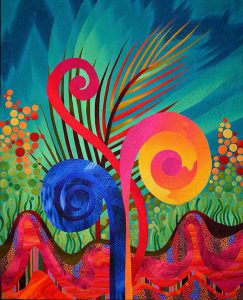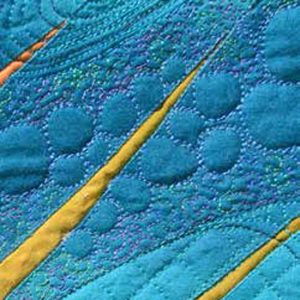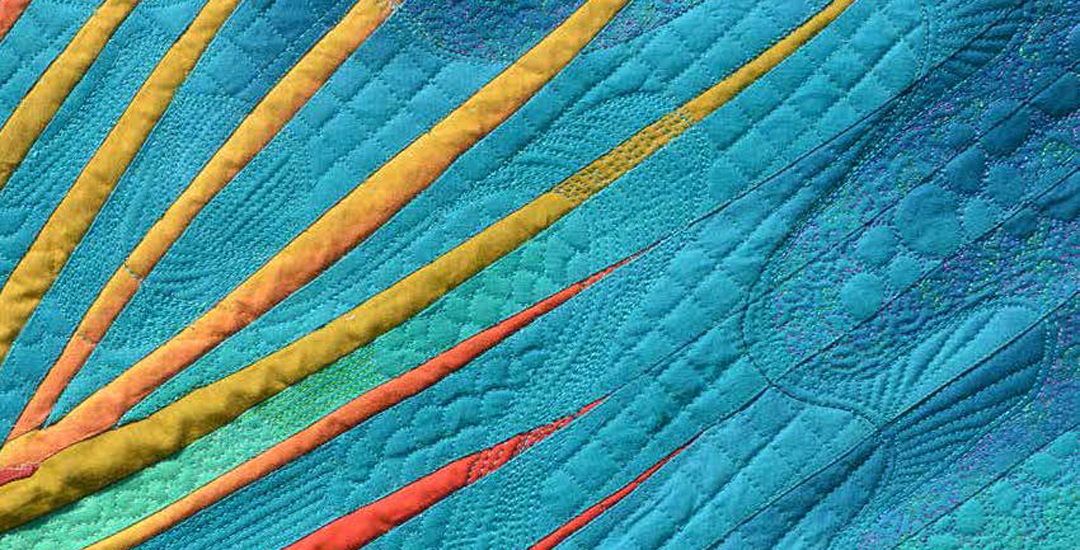Anyone reading this story who owns property with a shoreline can probably relate to the anxiety caused by high water levels. In the spring of 2017, record-breaking rainfall and a dubious water management strategy put into effect on the St. Lawrence, resulted in widespread flooding on both sides of the border.

The Wet Spring of 2017 won Best of Show at Quilt Canada 2018 in Vancouver, BC; 44.5″ x 60.5″
Techniques: Home-machine appliqué, piecing and quilting.
Artist Statement: Record water levels made our spring exciting.
Our property will never be the same.
Our retaining wall is gone, we have less grass to cut and the wetlands have been restored.
As the water withdrew and the sun came out, the new growth came in vibrant and full of promise.
Photos: Robert Fujiki
We watched helplessly as our property in Prince Edward County, ON, eroded away with every windblown wave. The shoreline disappeared, our beautiful natural rock retaining wall collapsed and ten feet of lawn was swept away. We were lucky. The damage stopped there. Our home was safe and the clean up after the water receded was manageable. Both of our immediate neighbours were not as lucky and discovered, to their dismay, they were actually located on a designated flood plain.
The dubious water management plan was put in place to allow more variation in water levels to improve the health of wetlands (it is being reviewed). It created more wetlands, definitely, but wasn’t good news for homeowners. I always admire the heavy growth of ferns on our neighbours’ property. My fiddlehead series of quilts is inspired by that foliage!
Perhaps you are wondering why I am going on about the flooding. For me, it is much easier to start an original quilt design when I am invested in the subject matter. As devastating as the whole flood experience was, new growth would happen. My fiddlehead friends would be back. Grass would rejuvenate, the rocky shore would be rearranged time and time again and those glorious ferns would reach for the sun!

In creating The Wet Spring of 2017, I wanted to try for a “wet” look, if that makes any sense. I achieved the look by using a gradation of greens and blues in the background seaming. The placement of the fern aligned with the seaming. The pieces were very small and tricky to handle in the construction, so I used quilt grid fuse instead of freezer paper. Quilt grid fuse is marked and eliminates the need to set up hash marks to line up your piecing. Since it is lightweight, it does not have to be removed. This method is a variation of applipiecing which is used by Caryl Bryer Fallert-Gentry in her work. I adapted the method to suit my style.
I constructed the background placing the fern first. Then, I pieced the shoreline and connected the two. Everything is seamed and turned under a quarter inch. I used monofilament thread and a very narrow zigzag stitch (width of one, length of one) on all edges. I prepared the grass and spores – all turned under a quarter inch – using a slightly heavier-weight, fusible interfacing and the Apliquick™ method. The fiddleheads were added next and the background under them was cut away. The last step was to place the grass and spores.

I am celebrating the new growth and the positive changes taking place on our property. This quilt will hang in our home as a reminder of that wet spring for years to come.
Helen Fujiki lives and quilts in West Hill, ON.


